| Article ID | Journal | Published Year | Pages | File Type |
|---|---|---|---|---|
| 6287824 | Fungal Biology | 2016 | 21 Pages |
Abstract
The effects of light at different wavelengths and photoperiod on growth and ochratoxin A production of Aspergillus carbonarius and Aspergillus westerdijkiae were studied: far-red (740Â nm), red (625Â nm), blue (445Â nm), and UV-A (366Â nm). Fungal growth was not significantly affected by photoperiod or light wavelength; the only exception was A. westerdijkiae which showed reduced growth under UV-A light (366Â nm). Short-wavelength blue light (445Â nm) and UV-A light caused a reduction in ochratoxin A production of both fungal species. However, long-wavelength red light (625Â nm) and far-red light (740Â nm) reduced ochratoxin A production only in A. westerdijkiae but not in A. carbonarius. It is believed that this difference in reactivity to light is due to differences in the melanin content of the two fungal species: A. carbonarius is a black fungus with higher melanin content than A. westerdijkiae, a yellow fungus. Other possible explanations for the reduction of ochratoxin A production by light were also discussed.
Related Topics
Life Sciences
Agricultural and Biological Sciences
Agricultural and Biological Sciences (General)
Authors
Khai Khuang Cheong, Caroline Strub, Didier Montet, Noël Durand, Pascaline Alter, Jean-Christophe Meile, Sabine Schorr Galindo, Angélique Fontana,
